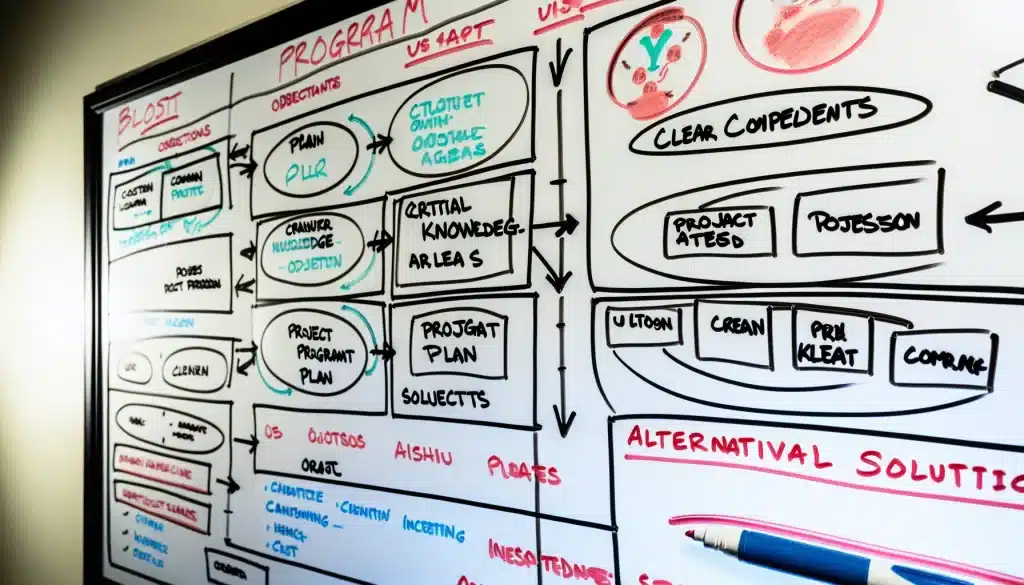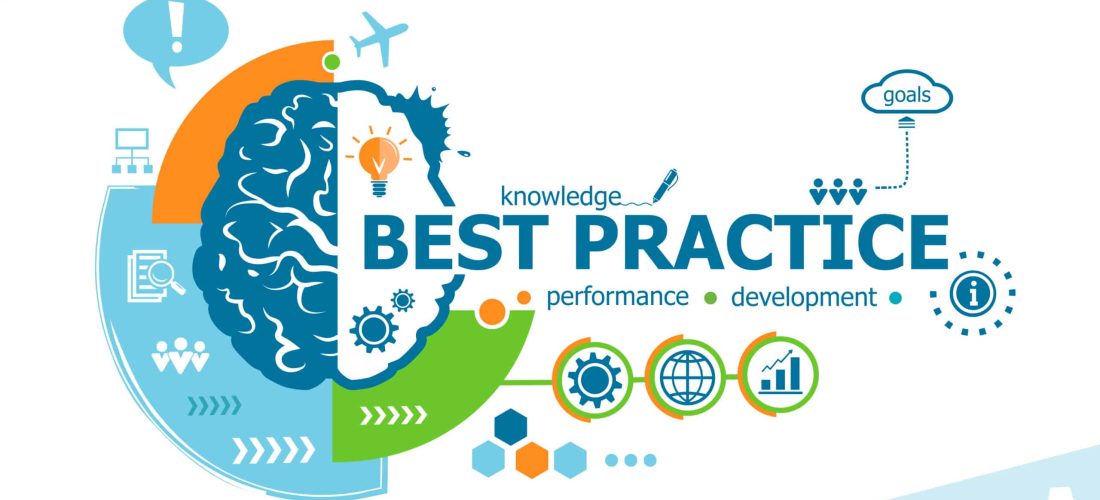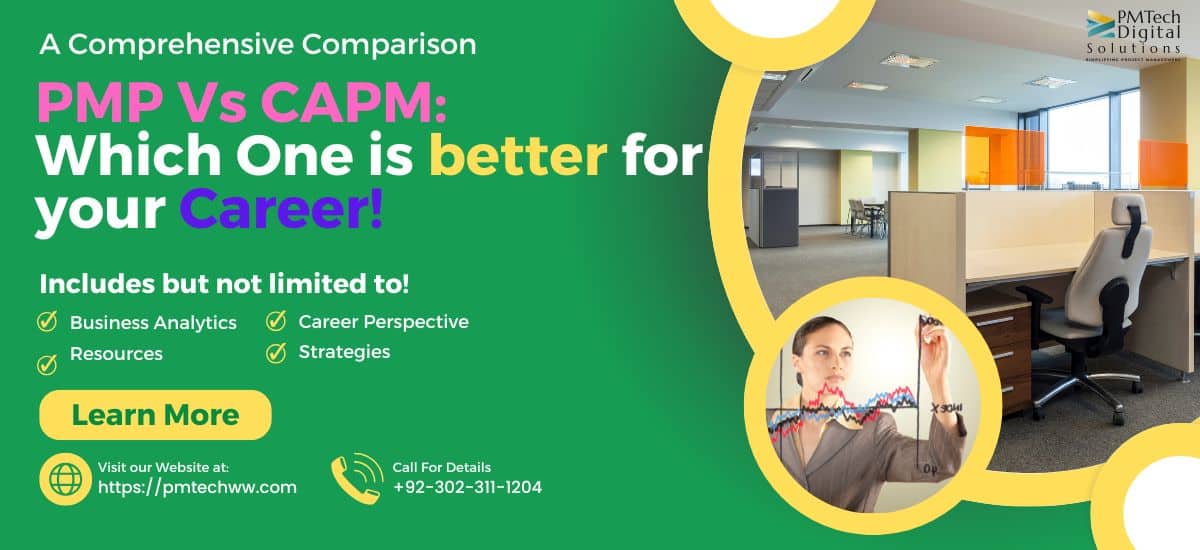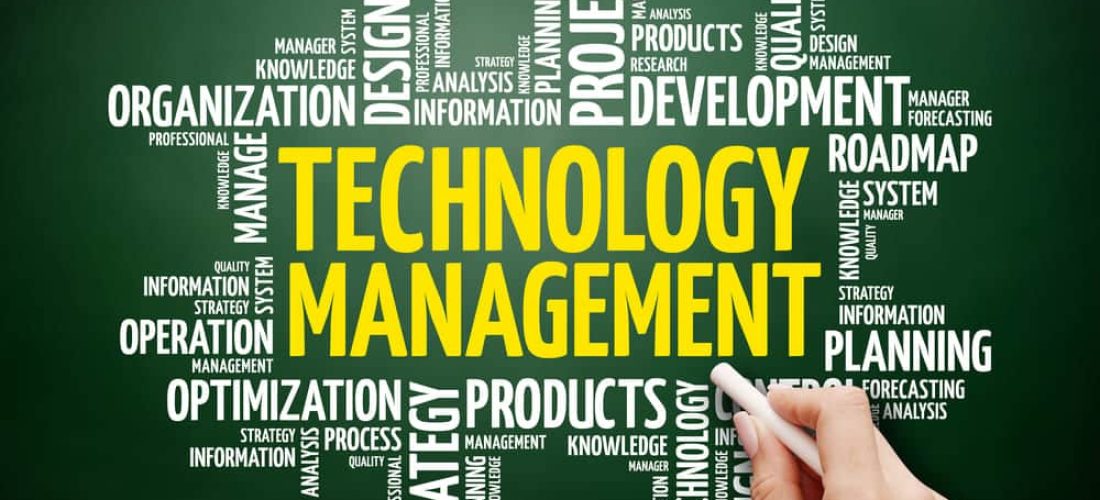Transforming strategic plans into successful outcomes is the essence of program management. This clear-cut article outlines the 10 best practices for program management success, directing you toward effective leadership of complex projects. It walks through establishing a robust PgMO, fostering effective communication, and harnessing software solutions, all with a focus on results.
Key Takeaways
- Establishing a strong Program Management Office (PgMO) is essential for ensuring effective governance, resource allocation, and alignment with organizational goals, as it harmonizes various projects and orchestrates their optimal execution.
- Developing a comprehensive program plan is the foundation for guiding a program to success, incorporating key components such as scope, cost, time, and risk, and necessitating regular updates to adapt to changing circumstances.
- Measuring and monitoring program performance through relevant Key Performance Indicators (KPIs) is vital for staying on track with project control variables, enabling proactive optimizations, and guiding strategic decision-making.
Establish a Strong Program Management Office
The successful conduct of program management requires a strong Program Management Office (PgMO). This acts as an anchor ensuring the proper governance, resource distributions and keeping in line with the company desires. One can consider PgMO as a conductor, coordinating various projects and making sure they fall under the grand plan of the organizations, while also minimizing the waste of resources. Knowing the project strategic context is vital inserting the project within long-side objectives and from a broader business perspective, as well, including potential ROI and budget but also resource constraints.
Further Reading: The Ultimate Decoding: Project Vs Program Manager Difference

Roles and Responsibilities
In summary, the PgMO has a considerable number of responsibilities and plays many roles . Foremost, it ensures a governance framework within the powerful duties and obligations and decision-making capabilities of every stakeholder in a venture is put in place. A messenger, which collects knowledge from multiple relevant sources and passes it on to its consumer.
PgMO strategically manages the resource allocation process and maintains effective project management while achieving strategic goals of an organization. Performs monitoring through performance assessment, which provides feedback for producing correct decisions to make a project successful.
Benefits of a PgMO
Having gained the proper structure, PgMO may provide the following important advantages. The first and probably the most important one is that the PgMO company acts as a lighthouse, which plays a key role in making sure every project strives to meet and deliver what’s important in our organization.
Secondly, the PgMO is the ever-vigilant sentinel, helping keep costs under control because they meticulously watch project spending and keep me informed. Finally, PgMO is a glass house. It’s more visibility and a clear line of communication for me, as well as everyone else. Finally, in the distant future, PgMO is a mentor/coach.
Develop a Comprehensive Program Plan
In conclusion, having a complete project plan plays an instrumental role in adequately manage your program. Additionally, it is vital to note that keeping the critical project documents up to date through the lifecycle of the project. It helps ensure that the plan as a whole stands as a source document, giving you a clear path to ensure your success.
Moreover, to effectively monitor and control the entire program, it would be advantageous to have a separate master project containing all the agency’s critical milestone links. This is in order so as to support the interconnection between the projects .
Finally, when defining strategic objectives for your program, it is crucial to consider how much or what proportion of the same the individual projects bring about. The values included are based on the direction in which resources are allocated with respect to the overall strategy.

Key Components
A good program plan consists of a number of vital components. First of all, it is the clear definition of what steps need to be taken to achieve the goal. Additionally, it is critical to include the items related to time, quality, scope, cost, physical and human resources, procurement, communication, risk management, and stakeholder management. Finally, one should assume all possible resolutions to the issue and choose the best one using financial, temporal, and opportunities constraints that establish a new bar.
Monitoring and Updating
It is essential for program managers to be constantly monitoring and revising the project plan. This is analogous to the way a ship’s captain modifies their course in response to altering winds and currents. One of the most important roles that consistent communication through frequent project meetings plays is in:
- Gathering updates
- Addressing any obstacles
- Ensuring steady progress of the project
- Adaptation to changes.
Furthermore, deadlines and milestones are not only an incentive for a team but also an opportunity for a project manager to evaluate the undertaken production measures. The use of checklists can help register the measures taken at different stages of the project.
Assemble a High-Performing Team
Creating a high-performing team is crucial for any project manager who is aiming for success. Indeed, teamwork and productivity are two of the top elements which define the ultimate quality of the project. If people of different backgrounds unite and work on one shared goal, it starts working like a clock: one can quickly take decisions, and the implementation would be simply ideal.

Team Selection Criteria
Assembling a team to work with at the conference is almost like putting a puzzle together, every piece of which matters. While selecting people for your assembly, ensure to choose them by cognitive diversity, which means gathering people with different thinking perspectives.
This approach will enable a team with a better solutioning vision due to different experiences and the lack of danger of group thinking, which can disturb the whole decision-producing mechanism. Thus, the best solutioning emerges.
Fostering Collaboration
A team can be likened to a symphony; every instrument is important to playback the delightful music. The behaviors look at inclusivity as more than just acknowledging the presence of diversity but the cooperation that it upholds.
Having everyone share space and exchange ideas erodes all sorts of biases that may exist. To this end, it is essential to establish and acknowledge the occurrence of conducive behavior that upholds the teamwork for all the members to maintain focus on the goal.
Implement Effective Communication Strategies
The viability of communication is frail without ensuring that everyone is kept in the loop and that any significant issues are immediately addressed. This implies that the project manager, stakeholder, and team member should keep strong lines of open and transparent communication. Honest communication combined with sincere listening creates a beneficial work culture in which all colleagues are honored and their ideas are given fair consideration.

Channels and Tools
Each communication tool is like a director’s sight; in other words, different communication channels and tools are what guides a program manager. Information about available communication channels is essential to decide on the format and methods of disseminating necessary data and the appropriateness of the timing.
Thus, multi-view instruments are to be included, since some stakeholders depict information better via a Kanban board, and others might need a calendar be displayed.
Stakeholder Engagement
Engaging with stakeholders could fit to the concept of nurturing a garden, but it is crucial because other obstacles that they might create could quickly outweigh any benefits. It is vital to manage stakeholder throughout the entire duration of the project, starting from obtaining project charter approval.
For that, a stakeholder register spreadsheet has to be created, listing influence, interest, and potential impacts of all stakeholder groups. If this is done, communication methods may be tailored to each of them.
Define Clear Goals and Objectives
Just like the North Star is a common beacon for ships to navigate the open seas, the same can be said about goals and objectives when it comes to the project field. Without a clear, thus feasible set of goals, or the ability to track the projects’ processes, there’s no way of truly determining how well the project is moving along. Setting clear goals is a best practice in the project field.
When talking about how everyone is kept on the same page regarding what they have to do when it comes to how it helps to keep the project members from turning as Nazis to each other in order to ensure there is zero decrease in productivity, this one takes the cake.
Documentation of change requests is another good practice in project management that is acknowledged as being helpful. It keeps the project from spilling over and getting out of hand.
Aligning with Organizational Strategy
The analogy of the alignment of project goals with organizational strategy can be compared to the movement in the ballet that runs synchronously with another. Therefore, Program Management Offices (PgMOs) need to ensure the highest level of alignment between their program and portfolio management and the corresponding operational and strategic objectives. This comprises intentional prioritization in selecting projects to pursue as well as active enrollment in the strategic planning process.
KPIs – key performance indicators are one of the crucial elements of the monitoring process as far as the extent to which PMO objectives correspond to the goals of the entire organization is concerned. In accordance with the SMART approach – specific, measurable, detailed – great attention must be paid to their selection.
Tracking Progress
Project tracking is simply monitoring your project’s progress from inception to completion. Unequivocal and feasible targets allow the teams to have a shared objective and aligned them as if to ascertain staff motivate their struggle, whereas rigid deadlines pilot and inspire team members’ endeavors.
Some other tools you can use to keep track of progress and process the various stages and tasks of a project include project dashboards, checklists, and customizable templates, among others. Additionally, they can facilitate maintaining track of project-related documents.
Manage Program Risks Proactively
Regarding the responsibility of the risk management in program management, it is similar to the performance of a safety net among trapeze artists. Indeed, risk management serves as a guard for the un-called for eventualities. In that case, it also does a great job of defining and assessing how likely the risks discovered could occur in the program.
Create a centralized Program Management Office (PgMO) that can strategically keep an eye on the all project under the program or portfolio. Clearly define and documented the project slide is a requirement.
This would be useful in the risk assessment process to manage prevent scope creep. This will ensure that changes in requirements or schedule of tasks do not have negative effect on the project’ timeline budget.

Risk Assessment Techniques
Risk assessment in project management is similar to the work of a private detective. The task, in this case, is to find, evaluate, and neutralize potential dangers and risks. This whole process consists of 4 stages: identification, categorization, evaluation, and documentation of risk.
First, it is vital to define each and every possible risk that can be found with this or that project and realize its possible damage to the result. Then, all the information has to be thoroughly documented.
Risk Mitigation Strategies
Reflecting on some of the risk mitigation strategies, it may be noted that program managers address particular threats in the way a move to save a piece takes place in chess. Their strategies may involve avoiding the threat at all, accepting the threat’s direct course of action, or mitigating the effect by transferring it to a different context.
Further Reading: Risk Management: Ultimate Guide To Navigating Uncertainties
On the other hand, a complete risk assessment, predicting the likelihood of every threat, offered the means of avoidance, and acceptance under which the vendor, or a timeline, can be changed. The approaches of avoidance, acceptance, and acceptance, reduction, or transfer provided an opportunity to address the risks proactively during the project’s lifecycle.
Utilize Efficient Program Management Software
Program management software acts as a versatile tool, providing a range of features to assist in effective program management. Some of the key features of program management software include:
- Scheduling projects
- Monitoring team availability
- Tracking workloads and budgets
- Providing visual representations of tasks through tools like Gantt charts and Kanban boards
Use program management software. The use of program management software will enable you to ease your program management processes and increase the efficiency of implementation. Centralized data and real-time visibility made possible by program management software will improve collaboration and support decision-making. It will also allow resource allocations to be efficient and project resourcing costs lowered.

Increasingly, program management software is important in resolving the challenges and the complexities that come with managing projects as it will ensure team alignment, and that whereby projects are well documented, there is no information silo because all information is shared. Eventually, this will be one of the success factors of the program.
Features to Look For
It can be compared to choosing ingredients for a recipe – every single thing is important for the final result. A good project management software must have elements of planning and organization, such as Gantt charts , the possibility to track the task, and tools for understanding the allocation of resources.
The team can work together better through the ability to share the file, give every of its member access to its own calendar, a centralized repository for storing files or documents, and a message directly from the application.
Further Reading: Best Alternatives Of Microsoft Project: For Streamlined Project Management In 2024
Benefits of Using Software
The advantages of utilizing program management software are abundant, much like a tree that bears ample fruit. Among the benefits are:
- Minimizing workload by automating tedious tasks
- Enabling project managers to prioritize more important duties
- Handling numerous projects concurrently
Software-generated scheduling and reporting boosts the chances of achieving success in projects and guarantees no task is neglected.
Foster Continuous Learning and Improvement
Various PgMO best practices are implemented in the organization, including support and facilitation of continuous learning and improvement. It is important to emphasize that PgMO operates in a manner of an ongoing process rather than a final goal. The best way to achieve this culture is to embed and follow the best project management practices and project management best practices . They lay a strong foundation for a culture of continuous learning.
They improve project to project collaborations, obtaining value-added products, team performance and finally transferring knowledge within the team. They also assist the PgMO in promoting a culture of sharing knowledge and best practices across project teams and using the right tools to promote these cultures which eventually ensure a continuous improvement culture is achieved.
To their duties as mentors for project managers, Project Management Offices also provide opportunities for professional development. This includes educating on the roles of being a project manager while nurturing leadership potential and retaining employees through effective utilization of proven project management techniques.
Regular Reviews and Feedback
In program management, regular reviews and feedback play a vital role in assessing the overall health of a project. Just like routine check-ups help identify any issues with our physical well-being, these evaluations pinpoint areas that need attention and reinforce successful strategies being implemented by team members. It is important for this feedback to be goal-oriented, specific, timely, and supportive so that it recognizes the efforts and talents of all individuals involved.
Actionable contextualized feedback is much more important since it helps team members grasp the way they can influence the orders’ achievement. It is not about self-improvement; it is about the motivation to work aligned with the set objectives more efficiently. Finally, the performance-based review will ensure the proper level of feedback’s relevance and action clarification.

Lessons Learned
Utilizing lessons from program management enables us to avoid repeating past errors, similar to how we learn from history. The Program Management Office (PgMO) improves the effectiveness of project management by providing resources such as templates, project plans, reviews and documentation for departmental teams. This facilitates efficient transfer of knowledge among team members.
Through lessons learned sessions, valuable experiences and knowledge are documented which helps in preventing recurring mistakes. These sessions serve as a platform for codifying information and enable teams to implement best practices while undertaking new projects.
Ensure Flexibility and Adaptability
The concept of flexibility in program management, in general, is similar to the ability of a river to bypass various obstacles changing its direction. In program management, being flexible is critical in the capacity of successfully managing unforeseen barriers and adapting to permanent changes in needs. In other terms, program management strategies must be adaptive to be effective and continuously reevaluated following any changes within the organization and beyond.
Managing Change Requests
Successfully maneuvering change requests in program management is much like steering a ship; change course. Because these alterations should be routinely approved and accepted, change request forms can help to manage them effectively. As part of the various essential project information that this form usually collects, urgency, impact on the project, alternatives if rejected, and effects on scope, cost, etc., play a significant role in ensuring its involvement in the change request process.
It is worth noting that approving change requests can take a heavy toll on a project. It may imply attracting additional resources or the staff and moving tasks up or down the schedule, as well as using additional features or technologies . Thus, their significance is hard to overestimate as they can transform the whole project.
Resource Reallocation
Strategic reallocation of resources in the same manner that chess pieces are shuffled to deliver maximal value is implied in an effective program. Secondly, deploying agile resource management approaches to guarantee flexibility and the ability to pivot as the circumstances evolve.
Further Reading: Mastering Agile Methodologies: Ultimate Guide To Transformative Project Management
Finally, understanding that resource allocation is a continuous exercise that necessitates regular assessment and realignments that are aligned with the broader organizational agenda.
Measure and Monitor Program Performance
Regularly consulting the compass to avoid losing one’s way is the same as regularly measuring and monitoring program performance. It is required that all Key Performance Indicators be comprehensive to cover essential project control elements, particularly cost, time, scope, quality, benefits, and risks . Continuously track expenditures and receive updates on the financial situation as soon as feasible, to facilitate high levels of project spend.
Selecting Relevant KPIs
Picking appropriate KPIs for program management is akin to selecting the perfect lens for a camera, honing in on essential elements. The selection of Key Performance Indicators (KPIs) should be made early on in the program and follow S.M.A.R.T guidelines.
- Specific
- Measurable
- Attainable
- Relevant
- Time-bound
This will effectively monitor advancement towards strategic goals.
Analyzing Data and Taking Action
The process of analyzing data and implementing strategies in program management can be likened to a doctor diagnosing a patient’s illness and prescribing necessary treatment. To effectively monitor project performance, the PMO should keep track of Key Performance Indicators (KPIs) such as effectiveness, quality, budget, productivity, and timeliness.
In order to evaluate project success and identify areas for improvement within an organization or company’s projects, it is essential to systematically measure these KPIs. Through comparing planned values with actual performance using appropriate metrics that highlight variances which may signal issues or problems within the project. Without analysis, that is possible only when the project is based solely on opinion and judgment of the project managers.
Data analysis is, therefore, crucial to successful project management as the system does not rely on the opinion of the ones involved or affected by the project. Through data analysis, the Program Management Office (PgMO) can track performance indicators that include effectiveness rates. Productivity measures, and timely delivery milestones. These will provide insight into how well the objectives are being fulfilled.
Summary
In conclusion, great success in Program Management can be accomplished through early planning, proper communication, team collaboration, and consistent learning . Below are tips that help you make any seemingly massive project a fun venture. Ensure you have a strong Program Management Office and project plan, create a unique team, adopt productive communication channels, and set clear goals and objectives right from the project launch. You will also need guided risk management, helpful software, and finally, the spirit of growth and improvement.
Frequently Asked Questions
What role does a Program Management Office (PgMO) play in an organization?
The presence of a Program Management Office (PgMO) is essential in effectively coordinating projects with an organization’s strategic objectives, efficiently managing resources, and offering assistance to project managers. This office plays a crucial role in ensuring the success and productivity of project management throughout the organization.
By aligning projects with company goals, optimally distributing resources among them, and providing support to those overseeing each individual project, a PgMO significantly contributes towards achieving efficient and successful outcomes for all endeavors within the organization. The responsibilities entrusted upon the responsibilities assigned to the responsibilities.
Why is a comprehensive program plan important?
An all-inclusive program blueprint holds significance as it acts as a guide for the project, aids in overseeing and regulating project tasks, allocating resources and adhering to timelines, while also preventing any expansion of scope beyond initial boundaries. It offers guidance and organization for ensuring successful implementation of the project.
What are the benefits of using project management software?
Project management software is a valuable tool that can streamline tasks, oversee various projects, enhance team communication and cooperation, and ultimately boost project success. This type of software automates important processes within the realm of project management, making it easier to manage projects.
Project management software
How can program management be made more flexible and adaptable?
It is essential to continuously reassess tactics, effectively handle change requests, and reassign resources in order to enhance the flexibility and adaptability of program management. This allows for a more efficient response to evolving circumstances and demands.
By consistently reviewing strategies, properly managing any changes that arise, and reallocating necessary resources as needed, can greatly improve the overall success of a program. Regular evaluations of strategies along with effective handling of change requests enable programs to succeed.
How can the performance of a program be measured and monitored?
Efficiently evaluating and tracking a program’s performance requires the establishment of specific and achievable objectives, identification of suitable key performance indicators (KPIs), continuous monitoring of project implementation within designated timeframes and budget constraints, as well as measuring qualitative advancements based on feedback from clients. Taking this holistic approach guarantees a comprehensive evaluation of project execution.

















182 Responses
Your article helped me a lot, is there any more related content? Thanks!
Your article helped me a lot, is there any more related content? Thanks!
Thanks for sharing. I read many of your blog posts, cool, your blog is very good.
Can you be more specific about the content of your article? After reading it, I still have some doubts. Hope you can help me.
Thanks for sharing. I read many of your blog posts, cool, your blog is very good.
I don’t think the title of your article matches the content lol. Just kidding, mainly because I had some doubts after reading the article.
маркетплейс аккаунтов соцсетей магазин аккаунтов
маркетплейс аккаунтов соцсетей маркетплейс для реселлеров
продажа аккаунтов соцсетей https://magazin-akkauntov-online.ru/
аккаунты с балансом продать аккаунт
аккаунты с балансом магазин аккаунтов
купить аккаунт https://kupit-akkaunt-top.ru/
купить аккаунт с прокачкой https://pokupka-akkauntov-online.ru/
Account exchange Secure Account Purchasing Platform
Account Trading Platform Sell Account
Ready-Made Accounts for Sale Guaranteed Accounts
Account Selling Platform Account Market
Account Buying Service Social media account marketplace
Account Purchase Account Purchase
Verified Accounts for Sale Marketplace for Ready-Made Accounts
Account Selling Platform Account Purchase
Sell Account Social media account marketplace
Database of Accounts for Sale Buy Account
account trading platform verified accounts for sale
sell pre-made account accounts for sale
find accounts for sale account market
website for selling accounts account market
guaranteed accounts purchase ready-made accounts
purchase ready-made accounts accounts market
account exchange service find accounts for sale
account buying platform accounts marketplace
account trading guaranteed accounts
Hi there! This is my first visit to your blog! We are a collection of volunteers and starting a new initiative in a community in the
same niche. Your blog provided us useful information to
work on. You have done a extraordinary job!
Also visit my website :: nordvpn coupons inspiresensation
buy account account market
gaming account marketplace account trading
account catalog database of accounts for sale
account sale https://social-accounts.org
secure account purchasing platform buy pre-made account
purchase ready-made accounts account catalog
Very good article! We are linking to this particularly great post on our site.
Keep up the great writing.
Here is my web page nordvpn coupons inspiresensation (easyurl.cc)
buy pre-made account guaranteed accounts
account trading platform ready-made accounts for sale
account marketplace account trading platform
account buying service https://buy-social-accounts.org/
sell pre-made account account catalog
account marketplace buy and sell accounts
account trading platform https://accounts-market-soc.org/
account exchange service https://sale-social-accounts.org
gaming account marketplace sell pre-made account
account catalog account exchange service
ready-made accounts for sale account market
account exchange gaming account marketplace
accounts marketplace account marketplace
account trading platform https://accounts-marketplace.xyz
nordvpn coupon
350fairfax
Please let me know if you’re looking for a author for your blog.
You have some really good articles and I think I would be a good asset.
If you ever want to take some of the load off, I’d
absolutely love to write some articles for your blog in exchange for
a link back to mine. Please send me an e-mail if interested.
Thanks!
account trading https://social-accounts-marketplaces.live/
account catalog buy accounts
purchase ready-made accounts https://social-accounts-marketplace.xyz
verified accounts for sale https://buy-accounts.space/
account purchase https://buy-accounts-shop.pro
database of accounts for sale https://buy-accounts.live
account buying service https://accounts-marketplace.online
account market https://social-accounts-marketplace.live
магазин аккаунтов akkaunty-na-prodazhu.pro
маркетплейс аккаунтов https://rynok-akkauntov.top/
маркетплейс аккаунтов соцсетей https://kupit-akkaunt.xyz/
маркетплейс аккаунтов https://akkaunt-magazin.online
купить аккаунт akkaunty-market.live
маркетплейс аккаунтов соцсетей https://kupit-akkaunty-market.xyz/
купить аккаунт https://akkaunty-optom.live
магазин аккаунтов online-akkaunty-magazin.xyz
продажа аккаунтов akkaunty-dlya-prodazhi.pro
купить аккаунт https://kupit-akkaunt.online/
buy facebook profiles https://buy-adsaccounts.work/
buy account facebook ads https://buy-ad-accounts.click/
cheap facebook accounts https://buy-ad-account.top/
buying facebook account buy account facebook ads
buy fb ad account ad-account-buy.top
buy facebook accounts for advertising buy facebook ads account
facebook ad account for sale ad-account-for-sale.top
Эта публикация погружает вас в мир увлекательных фактов и удивительных открытий. Мы расскажем о ключевых событиях, которые изменили ход истории, и приоткроем завесу над научными достижениями, которые вдохновили миллионы. Узнайте, чему может научить нас прошлое и как применить эти знания в будущем.
Подробнее тут – https://medalkoblog.ru/
buy facebook advertising https://ad-accounts-for-sale.work
google ads account seller https://buy-ads-account.top
google ads account seller buy-ads-accounts.click
buy facebook account facebook ad accounts for sale
buy aged google ads accounts buy google ads invoice account
buy aged google ads account buy verified google ads accounts
buy google ads https://buy-ads-invoice-account.top
buy adwords account sell google ads account
buy google ads threshold accounts https://buy-ads-agency-account.top
buy google ads threshold accounts buy google ad threshold account
google ads agency accounts ads-agency-account-buy.click
buy verified bm buy-business-manager.org
buy google ads invoice account https://buy-verified-ads-account.work
buy business manager buy-bm-account.org
buy verified business manager buy fb business manager
business manager for sale buy-verified-business-manager.org
buy verified bm https://buy-business-manager-acc.org
verified bm https://business-manager-for-sale.org/
facebook bm account buy buy-business-manager-verified.org
buy facebook business manager verified https://buy-bm.org
facebook verified business manager for sale verified-business-manager-for-sale.org
buy facebook business manager verified https://buy-business-manager-accounts.org/
tiktok ad accounts https://buy-tiktok-ads-account.org
tiktok ads account for sale https://tiktok-ads-account-buy.org
tiktok ads account buy https://tiktok-ads-account-for-sale.org
buy tiktok ads accounts https://tiktok-agency-account-for-sale.org
tiktok ad accounts https://buy-tiktok-ad-account.org
buy tiktok ad account https://tiktok-ads-agency-account.org
buy tiktok ad account https://buy-tiktok-business-account.org
tiktok ads agency account https://buy-tiktok-ads.org
Can you be more specific about the content of your article? After reading it, I still have some doubts. Hope you can help me.
¡Hola, descubridores de riquezas !
Casinos extranjeros accesibles desde cualquier ubicaciГіn – https://www.casinoextranjerosespana.es/# casinos extranjeros
¡Que disfrutes de asombrosas triunfos legendarios !
¡Hola, estrategas del azar !
Casino sin licencia y verificaciГіn en segundos – https://www.casinossinlicenciaespana.es/ casinossinlicenciaespana.es
¡Que experimentes giros memorables !
¡Saludos, buscadores de tesoros!
Casinos extranjeros con depГіsito mГnimo desde 1€ – https://www.casinosextranjerosenespana.es/# п»їcasinos online extranjeros
¡Que vivas increíbles giros exitosos !
¡Hola, amantes del ocio !
casino por fuera sin lГmites de apuestas – https://www.casinoonlinefueradeespanol.xyz/ casinos online fuera de espaГ±a
¡Que disfrutes de asombrosas tiradas afortunadas !
¡Saludos, fanáticos del azar !
GuГa rГЎpida: jugar seguro en casinos online extranjeros – п»їhttps://casinoextranjerosenespana.es/ casinoextranjerosenespana.es
¡Que disfrutes de oportunidades exclusivas !
¡Saludos, aventureros del riesgo !
Bonos sin depГіsito en casinos online extranjeros – https://www.casinosextranjero.es/ casinosextranjero.es
¡Que vivas increíbles recompensas sorprendentes !
¡Hola, participantes del juego !
Casino online extranjero con lГmites de apuestas flexibles – https://www.casinoextranjero.es/# casinoextranjero.es
¡Que vivas recompensas fascinantes !
¡Bienvenidos, cazadores de tesoros !
Casino online fuera de EspaГ±a con RTP alto – https://www.casinoporfuera.guru/# п»їcasino fuera de espaГ±a
¡Que disfrutes de maravillosas tiradas afortunadas !
¡Saludos, usuarios de plataformas de juego !
Top casinos fuera de EspaГ±a para juegos de azar – https://www.casinosonlinefueraespanol.xyz/ casinosonlinefueraespanol.xyz
¡Que disfrutes de premios espectaculares !
¡Hola, amantes del ocio y la emoción !
Casino online extranjero sin lГmites de depГіsito – п»їhttps://casinosextranjerosdeespana.es/ п»їcasinos online extranjeros
¡Que vivas increíbles instantes únicos !
¡Bienvenidos, exploradores de oportunidades !
Casino fuera de EspaГ±a ideal para apuestas deportivas – https://www.casinofueraespanol.xyz/# casinofueraespanol
¡Que vivas increíbles conquistas brillantes !
¡Hola, descubridores de oportunidades únicas!
casinos fuera de EspaГ±a para grandes ganancias – https://www.casinosonlinefueradeespanol.xyz/ casinos fuera de espaГ±a
¡Que disfrutes de asombrosas movidas destacadas !
¡Saludos, exploradores de la fortuna !
Casinos extranjeros con promociones por lealtad – п»їhttps://casinoextranjerosdeespana.es/ casinos extranjeros
¡Que experimentes maravillosas tiradas afortunadas !
Hello keepers of pristine spaces !
Smoke Air Purifier – Dual Filtration System – http://bestairpurifierforcigarettesmoke.guru best air filter for smoke
May you experience remarkable rejuvenating atmospheres !
¡Hola, jugadores expertos !
Casino online sin licencia sin verificaciГіn obligatoria – п»їhttps://casinosinlicenciaespana.xyz/ casino online sin licencia espaГ±a
¡Que vivas increíbles jackpots impresionantes!
¡Bienvenidos, apasionados de la diversión y la aventura !
Casino sin registro sin nГєmero de telГ©fono – https://mejores-casinosespana.es/ casino sin licencia espaГ±ola
¡Que experimentes maravillosas tiradas afortunadas !
¡Saludos, apostadores talentosos !
Casinos sin licencia en EspaГ±a con soporte 24/7 – http://audio-factory.es/ п»їcasinos sin licencia en espaГ±a
¡Que disfrutes de asombrosas tiradas brillantes !
Hi! This is kind of off topic but I need some guidance from an established blog.
Is it difficult to set up your own blog? I’m not very
techincal but I can figure things out pretty quick. I’m thinking about making my own but I’m not sure where to start.
Do you have any tips or suggestions? Thanks
Also visit my web site; eharmony special coupon code 2025
¡Hola, cazadores de riquezas ocultas !
Casino sin licencia con experiencia personalizada – п»їcasinosonlinesinlicencia.es casino online sin registro
¡Que vivas increíbles victorias memorables !
¡Saludos, buscadores de tesoros escondidos !
Accede al casino sin licencia en segundos – п»їemausong.es mejores casinos sin licencia en espaГ±a
¡Que disfrutes de increíbles jackpots sorprendentes!
Greetings, participants in comedic challenges !
Funny adult jokes to send your best friend – http://jokesforadults.guru/ п»їfunny jokes for adults
May you enjoy incredible successful roasts !
Excellent post. I used to be checking continuously this blog and I’m inspired!
Very helpful information particularly the closing section 🙂
I care for such info a lot. I was seeking this certain info for a long
time. Thank you and best of luck.
My blog post … Vpn
¡Saludos, apasionados de la adrenalina y la diversión !
Casinos con bonos de bienvenida por registro – п»їhttps://bono.sindepositoespana.guru/# casino online bono por registro
¡Que disfrutes de asombrosas tiradas exitosas !
I don’t think the title of your article matches the content lol. Just kidding, mainly because I had some doubts after reading the article. https://accounts.binance.com/sv/register?ref=OMM3XK51
Greetings, aficionados of the ridiculous !
hilarious jokes for adults use life’s complications as material for comedic gold. The more complicated, the funnier it becomes. That’s what makes them irresistible.
short jokes for adults one-liners is always a reliable source of laughter in every situation. [url=https://adultjokesclean.guru/#]jokesforadults[/url] They lighten even the dullest conversations. You’ll be glad you remembered it.
classic hilarious jokes for adults You Forgot – п»їhttps://adultjokesclean.guru/ funny jokes for adults
May you enjoy incredible clever quips !
buy fb account accounts market account trading platform
buy facebook old accounts buy account sell account
Hello defenders of unpolluted breezes !
Many pet parents report fewer flare-ups after switching to the best pet air purifier in combination with better grooming routines. For open-plan homes, the best home air purifier for pets offers wide coverage and automatic detection. An air purifier for pet hair in the kitchen helps keep fur away from food preparation areas.
If your pets shed frequently, a best pet air purifier is essential for maintaining clean air. The unit runs silently in the background while improving air quality air purifier for petsCleaner air benefits everyone in the household, including guests.
Best Air Purifiers for Cat Hair with High Efficiency – п»їhttps://www.youtube.com/watch?v=dPE254fvKgQ
May you enjoy remarkable unmatched clarity !
Can you be more specific about the content of your article? After reading it, I still have some doubts. Hope you can help me.
¿Hola competidores del azar?
Muchas casas permiten realizar apuestas con montos mГnimos muy bajos, accesibles para todo tipo de usuarios.apuestas fuera de espaГ±aEsto democratiza el acceso al juego.
Casas de apuestas fuera de EspaГ±a no aplican bloqueos automГЎticos por actividad sospechosa. ConfГan mГЎs en el usuario. Pero ofrecen herramientas de seguridad optionless.
Casas apuestas fuera de espaГ±a: ventajas y recomendaciones – п»їhttps://casasdeapuestasfueradeespana.guru/
¡Que disfrutes de enormes premios mayores!
This was beautiful Admin. Thank you for your reflections.
I’m often to blogging and i really appreciate your content. The article has actually peaks my interest. I’m going to bookmark your web site and maintain checking for brand spanking new information.
Highly descriptive article, I liked that a lot.
Will there be a part 2? gamefly free trial https://tinyurl.com/23ww4xyv
I very delighted to find this internet site on bing, just what I was searching for as well saved to fav
very informative articles or reviews at this time.
Hi there to all, for the reason that I am genuinely keen of reading this website’s post to be updated on a regular basis. It carries pleasant stuff.
Hi, I desire to subscribe for this weblog to obtain newest updates, thus where can i do it please help out.
What is vpn protection https://tinyurl.com/2xsenm6a
whoah this weblog is great i love reading your articles.
Stay up the great work! You understand, a lot of people are searching around for this information, you could aid
them greatly.
Hello there! I could have sworn I’ve been to this website
before but after reading through some of the post I realized it’s new to me.
Anyways, I’m definitely delighted I found it and I’ll be book-marking and checking back frequently!
Hello everyone, all reward hunters !
New users can also benefit from welcome offers after their 1xbet login registration nigeria is complete. 1xbet ng registration With a few clicks, you can start placing bets via the 1xbet nigeria registration online portal. The official 1xbet nigeria login registration site provides seamless access to games, live betting, and account management.
Choose 1xbet-ng-registration.com.ng for a secure and intuitive betting experience built for Nigerian users. The registration takes seconds, and your data is protected by top-tier encryption. Plus, there are daily and weekly bonuses for active players.
Mobile-friendly 1xbet registration by phone number nigeria options – п»їhttps://1xbet-ng-registration.com.ng/
Enjoy thrilling triumphs !
Kind regards to all excitement fans !
Completing the 1xbet registration nigeria grants you membership in an exclusive club of bettors. You gain access to special promotions, loyalty rewards, and a community of fellow sports enthusiasts. [url=http://www.1xbet-login-nigeria.com/]1xbet ng login registration[/url] It’s more than just a betting account; it’s an entry into a vibrant community.
After completing the 1xbet nigeria registration online, you can use various methods to fund your account. The platform supports both bank cards and popular e-wallets in Nigeria. Choose the most convenient method for you and start playing without delay.
1xbet nigeria login registration | Full Guide – п»їhttps://1xbet-login-nigeria.com/
Wishing you incredible cash prizes !
¡Saludos a todos los seguidores del azar !
Casas de apuestas sin registro dni permiten jugar de forma inmediata. Apuestas online sin registro funcionan sin formularios ni verificaciones. casas de apuestas sin dni Casas de apuestas SIN dni permiten apostar SIN validaciГіn documental.
Apuestas deportivas sin dni estГЎn disponibles sin registro. Muchas casas de apuestas sin verificaciГіn aceptan criptomonedas y tarjetas virtuales. Apostar SIN registrarse garantiza privacidad completa.
Seguridad en casasdeapuestassindni.guru – п»їhttps://casasdeapuestassindni.guru/
¡Que goces de increíbles premios !
¡Mis mejores deseos a todos los amantes de la emoción !
Al elegir casino por fuera obtienes programas VIP con recompensas y soporte dedicado en espaГ±ol. [url=п»їhttps://casinosonlineinternacionales.guru/]casinos online fuera de espaГ±a[/url] Los servicios en lГnea permiten promos semanales transparentes y criptomonedas entre sus mГ©todos. AsГ tu banca rinde mГЎs y las sesiones fluyen mejor.
Explorando casinosonlineinternacionales puedes aprovechar bonos de bienvenida competitivos y lГmites configurables a tu gusto. Los servicios en lГnea ofrecen atenciГіn al cliente 24/7 y mesas exclusivas para VIP. De este modo aprovechas mejores cuotas y menos fricciГіn.
Casinosonlineinternacionales con bonos de registro – http://casinosonlineinternacionales.guru/
¡Que disfrutes de extraordinarias beneficios !
Envio mis saludos a todos los aliados eternos del casino !
Los casinos sin licencia en EspaГ±a permiten apostar en deportes menos comunes. Desde ligas menores hasta eSports, las opciones son variadas. [url=п»їhttps://casinosinlicenciaespana.blogspot.com/][/url] Por eso, un casino sin licencia en EspaГ±a ofrece mГЎs alternativas.
Un casino sin licencia espaГ±ola elimina comisiones en retiros. Esto maximiza las ganancias del jugador. Jugar en un casino sin licencia espaГ±ola resulta mГЎs rentable.
Casino online sin licencia espaГ±a con juegos nuevos – http://casinoonlineeuropeo.blogspot.com/#
Que disfrutes de increibles recompensas !
casino sin licencia espaГ±a
Envio mis saludos a todos los generadores de ganancias !
En casinosfueradeespana.blogspot.com los usuarios encuentran juegos Гєnicos que no aparecen en sitios regulados. Los usuarios destacan que casino por fuera permite apuestas en vivo con menor latencia. [url=https://casinosfueradeespana.blogspot.com/#][/url]. Las plataformas de casinosfueradeespana ofrecen mГ©todos de pago modernos y retiros instantГЎneos.
Las plataformas de casinos online fuera de espaГ±a ofrecen mГ©todos de pago modernos y retiros instantГЎneos. La experiencia en casino por fuera se caracteriza por retiros sin comisiones y depГіsitos flexibles. Gracias a casinosfueradeespana los jugadores pueden acceder a promociones especiales y giros gratis.
casino por fuera con retiros inmediatos – http://casinosfueradeespana.blogspot.com/#
Que disfrutes de increibles botes!
casino online fuera de espaГ±a
Doy la bienvenida a todos los companeros de ruleta !
La seguridad y el cifrado avanzado de casino sin kyc garantizan una experiencia confiable. Los apostadores valoran casinos sin kyc por aceptar criptomonedas como mГ©todo de pago. [url=п»їhttps://casinosinverificacion.xyz/][/url]. Algunos usuarios eligen casinos sin kyc porque permite apuestas en vivo con baja latencia.
ВїBuscas privacidad total? Con casinosinverificacion puedes jugar sin dar datos personales. En casino crypto sin kyc los retiros suelen ser instantГЎneos y sin lГmites mГЎximos. Los apostadores valoran casinos sin kyc por aceptar criptomonedas como mГ©todo de pago.
CГіmo empezar a jugar en casinos sin verificaciГіn casinos sin kyc fГЎ… – п»їhttps://casinosinverificacion.xyz/
Espero que disfrutes de increibles premios !
casinosinverificacion.xyz
Un afectuoso saludo para todos los entusiastas del juego !
Disfruta de la promoción 10€ gratis para empezar a jugar sin riesgos y con más emoción desde el inicio. Disfruta de la promoción 10€ gratis casino para empezar a jugar sin riesgos y con más emoción desde el inicio. [url=https://10eurosgratissindepositocasinoes.xyz/#][/url]. Disfruta de la promoción gana 10 euros por registrarte para empezar a jugar sin riesgos y con más emoción desde el inicio.
Disfruta de la promociГіn regГstrate y 10 euros gratis casino para empezar a jugar sin riesgos y con mГЎs emociГіn desde el inicio. Disfruta de la promociГіn 10eurosgratissindepositocasinoes para empezar a jugar sin riesgos y con mГЎs emociГіn desde el inicio. Disfruta de la promociГіn 10 euros gratis por registrarte para empezar a jugar sin riesgos y con mГЎs emociГіn desde el inicio.
Consigue 10 euros gratis sin deposito ahora y juega sin riesgos – п»їhttps://10eurosgratissindepositocasinoes.xyz/
Que tengas la fortuna de disfrutar de increibles botes!
winzingo 10 euros gratis
Un calido saludo a todos los ganadores de premios!
Cada vez mГЎs usuarios se registran en mejores casinos online internacionales gracias a sus promociones constantes. casino online internacional. Si quieres jugar sin restricciones, mejores casinos online internacionales es la mejor alternativa del mercado. El catГЎlogo de mejores casinos online internacionales incluye tragamonedas modernas y juegos de mesa clГЎsicos.
Cada vez mГЎs usuarios se registran en casino internacional online gracias a sus promociones constantes. Las ventajas de usar casino internacional online incluyen retiros rГЎpidos y soporte 24/7 en tu idioma. Las plataformas como casino internacional online destacan por su facilidad de uso y rapidez en pagos.
casino international con bonos sin depГіsito – п»їhttps://casinosinternacionalesonline.guru/#
?Que tengas la fortuna de disfrutar de increibles botes acumulados!
casino international
I am actually glad to read this website posts which includes
lots of useful information, thanks for providing these kinds of information. Eharmony special coupon code 2025 https://tinyurl.com/2xd9hovp
?Saludos cordiales a todos los exploradores de la suerte!
Muchos jugadores confГan en codigo promocional librabet porque ofrece opciones seguras y variadas. [url=http://librabetcasino.guru/#][/url] Con codigo promocional librabet se puede acceder fГЎcilmente a promociones exclusivas y mГ©todos de pago modernos. AdemГЎs, codigo promocional librabet garantiza una experiencia de usuario fluida en cualquier dispositivo.
Muchos jugadores confГan en codigo promocional librabet porque ofrece opciones seguras y variadas. Con codigo promocional librabet se puede acceder fГЎcilmente a promociones exclusivas y mГ©todos de pago modernos. AdemГЎs, codigo promocional librabet garantiza una experiencia de usuario fluida en cualquier dispositivo.
Descubre bonos y ventajas en librabet app ahora – п»їhttps://librabetcasino.guru/#
?Te deseo increibles triunfos !
codice bonus librabet
В данной обзорной статье представлены интригующие факты, которые не оставят вас равнодушными. Мы критикуем и анализируем события, которые изменили наше восприятие мира. Узнайте, что стоит за новыми открытиями и как они могут изменить ваше восприятие реальности.
Выяснить больше – https://quick-vyvod-iz-zapoya-1.ru/
?Warm greetings to all the expert bettors !
Players looking for exciting offers often choose no deposit bonus casino because it provides easy access to rewards. Many international platforms highlight bonus no deposit to attract new members and increase engagement. [url=https://nodepositbonusgreece.guru/#][/url] The popularity of such promotions continues to grow as gamblers search for the best deals in the market.
Players looking for exciting offers often choose casino no deposit bonus because it provides easy access to rewards. Many international platforms highlight no deposit bonus greece to attract new members and increase engagement. The popularity of such promotions continues to grow as gamblers search for the best deals in the market.
Why players love online casino no deposit bonus more than ever – п»їhttps://nodepositbonusgreece.guru/
?I wish you incredible encounters !
no deposit casino
A warm greeting to all the prize winners!
The trend of no deposit casino continues to grow in 2025, with more casinos adopting flexible bonus systems. [url=http://nodepositbonusgreece.xyz/][/url]. If you’re searching for the best offers, no deposit casino remains one of the most popular options online. Whether you prefer slots or live dealer games, no deposit casino gives you a way to start playing instantly.
Sites that feature casino no deposit bonus usually combine security, variety, and instant accessibility for users. Gamers often recommend checking casino no deposit bonus when comparing bonuses across different casinos in Greece. The trend of casino no deposit bonus continues to grow in 2025, with more casinos adopting flexible bonus systems.
Step by Step Guide to Unlock nodepositbonusgreecefree – http://nodepositbonusgreece.xyz/#
May you have the fortune to enjoy incredible rounds !
no deposit bonus
Excellent way of explaining, and nice piece of writing
to take facts concerning my presentation subject, which i am going
to present in academy.
Check out my blog; https://tinyurl.com/srtu2maf
A warm greeting to all the treasure seekers !
If you’re searching for the best offers, nodepositbonusgreece.xyz remains one of the most popular options online. Experts agree that nodepositbonusgreece.xyz attracts both beginners and experienced gamblers seeking extra value. [url=https://nodepositbonusgreece.xyz/][/url]. One of the biggest advantages of choosing nodepositbonusgreece.xyz is that it allows players to test games without initial investment.
The trend of no deposit bonus casino continues to grow in 2025, with more casinos adopting flexible bonus systems. One of the biggest advantages of choosing no deposit bonus casino is that it allows players to test games without initial investment. For anyone who wants to maximize rewards, no deposit bonus casino can be the perfect starting point in online gambling.
Top Online Sites with no deposit bonus greece Available Today – http://nodepositbonusgreece.xyz/#
May you have the fortune to enjoy incredible victories !
bonus no deposit
Cheers to every bet masters !
Players who love Mediterranean style and excitement often choose casinoonlinegreek for its vibrant atmosphere and authentic games. [url=http://casinoonlinegreek.com/#][/url]At casino greek online, you can explore hundreds of slots, live dealers, and bonuses inspired by Greek culture. This casinoonlinegreek destination combines ancient myths with modern gaming technology, creating an unforgettable experience.
Players who love Mediterranean style and excitement often choose casino online greek for its vibrant atmosphere and authentic games. At online casino greek, you can explore hundreds of slots, live dealers, and bonuses inspired by Greek culture. This casino online greek destination combines ancient myths with modern gaming technology, creating an unforgettable experience.
Play Smarter at greek online casino – Trusted Greek Casino Choice – п»їhttps://casinoonlinegreek.com/
May you have the fortune to enjoy incredible Here’s to unforgettable jackpots !
Cheers to every profit seekers !
Players who love Mediterranean style and excitement often choose online greek casino for its vibrant atmosphere and authentic games. [url=https://casinoonlinegreek.com/#][/url]At casinoonlinegreek, you can explore hundreds of slots, live dealers, and bonuses inspired by Greek culture. This online greek casino destination combines ancient myths with modern gaming technology, creating an unforgettable experience.
Players who love Mediterranean style and excitement often choose casinoonlinegreek.com for its vibrant atmosphere and authentic games. At greek online casino, you can explore hundreds of slots, live dealers, and bonuses inspired by Greek culture. This casinoonlinegreek.com destination combines ancient myths with modern gaming technology, creating an unforgettable experience.
Explore the Thrill of casino greek online – Real Games, Real Wins – п»їhttps://casinoonlinegreek.com/
May you have the fortune to enjoy incredible Hope you score great rounds !
?Calidos saludos a todos los companeros de ruleta !
Las videollamadas seguras requieren plataformas confiables. Algunas aplicaciones cifran [url=http://casinossindni.space/][/url] las conversaciones de punta a punta. Es la forma mГЎs efectiva de evitar escuchas no deseadas.
Un casino sin dni espaГ±a permite jugar de inmediato tras el registro. No hay validaciones ni esperas para empezar a apostar. En pocos segundos, ya puedes probar suerte en tu juego favorito.
Casino sin DNI en EspaГ±a con soporte 24/7 – https://casinossindni.space/#
?Les deseo increibles victorias !
п»їcasinos sin dni
?Salud por cada maestro del giro!
Muchos jugadores eligen casinosinternacionalesonline.space por su libertad y rapidez en los pagos. [url=п»їhttps://casinosinternacionalesonline.space/][/url] La seguridad y el anonimato son ventajas clave de casinosinternacionalesonline.space. Las promociones en casinosinternacionalesonline.space se actualizan cada semana con grandes beneficios.
Muchos confГan en casinos internacionales por su reputaciГіn y variedad internacional. Las plataformas de casinos internacionales admiten criptomonedas y ofrecen retiros instantГЎneos. El catГЎlogo de casinos internacionales incluye tragamonedas, ruletas y juegos en vivo.
Comparativa de los mejores casinos internacionales online 2025 – https://casinosinternacionalesonline.space/#
Que tengas la fortuna de disfrutar brindemos por inolvidables pagos!
?Brindemos por cada aventurero de riquezas !
Los casinos sin kyc tienen sistemas de circuit breakers. Pausas automГЎticas ante actividad sospechosa detectada. [url=п»їhttps://casinossinverificacion.net/][/url] ProtecciГіn colectiva sin intervenciГіn manual necesaria.
Un casino crypto sin kyc implementa rollups para transacciones baratas. Costos mГnimos incluso en redes congestionadas. TecnologГa layer-2 hace microtransacciones viables siempre.
Casino crypto sin kyc paga ganancias sin demoras – п»їhttps://casinossinverificacion.net/
?Que la fortuna te sonria con deseandote el placer de triunfos !
?Celebremos a cada especialista en estrategias !
Algunos usuarios prefieren casino online sin registro porque permite comenzar a jugar en segundos sin burocracia. [url=http://bar-celoneta.es/#][/url] Las guГas de casinos sin kyc explican cГіmo aprovechar estas ventajas. Por eso crece su popularidad en toda la comunidad.
Muchos jugadores buscan casino crypto sin kyc para evitar trГЎmites, y esta alternativa ofrece comodidad inmediata. AdemГЎs, sitios como crypto casino no kyc ayudan a comparar opciones fiables. AsГ los usuarios encuentran plataformas seguras con facilidad.
casino gratis sin registrarse con diversiГіn inmediata – http://bar-celoneta.es/#
?Que la suerte te acompane con que consigas sorprendentes exitos !
?Brindemos por cada fabricante de prosperidad !
Muchos jugadores buscan plataformas rГЎpidas y sin registros. [url=http://durabilite.es/][/url] Sin embargo, estas pueden tener seguridad deficiente. Por eso se aconseja consultar durabilite.es antes de apostar.
Muchos usuarios desconocen los peligros de pГЎginas que ofrecen servicios de apuestas sin verificaciГіn ni controles de seguridad. Consultar durabilite.es puede ayudar a comprender mejor los riesgos asociados a plataformas no reguladas.
Evita mejores casas de apuestas sin licencia sin regulaciГіn – https://durabilite.es/#
?Que la fortuna te sonria con que obtengas extraordinarios apuestas triunfantes !
?Brindiamo per ogni creatore di prosperita !
La sicurezza nel gioco online richiede attenzione soprattutto riguardo alla navigazione protetta. Prestare attenzione ai dettagli tecnici permette di evitare problemi futuri [url=https://infinitumondovi.it/casino-senza-invio-documenti/][/url]. In questo modo ogni sessione di gioco risulta piГ№ serena e protetta.
La sicurezza nel gioco online richiede attenzione soprattutto riguardo alla supporto clienti. Una buona conoscenza degli strumenti di sicurezza aiuta a prevenire incidenti indesiderati. La prevenzione ГЁ sempre il metodo migliore per evitare rischi inutili.
Casino online senza documenti adopta innovaciГіn constante – http://infinitumondovi.it/casino-senza-invio-documenti/#
?Che la fortuna ti sorrida con che tu ottenga spettacolari conquiste eccezionali !
?Celebremos a cada devoto del destino !
Jugar en casino sin dni permite acceder a una experiencia rГЎpida y privada sin procesos complicados. [url=http://casinoretirosinverificacion.com/#][/url] Muchos jugadores optan por estas opciones debido a la libertad que ofrecen plataformas como casino sin verificaciГіn. Gracias a esta flexibilidad, cada sesiГіn se vuelve mГЎs cГіmoda al usar servicios como casinoretirosinverificacion.com.
Jugar en Casino Retiro Sin VerificaciГіn significa comenzar en segundos. Casinos sin verificaciГіn aceptan mГ©todos modernos de pago como criptomonedas. Casino sin dni es perfecto para quienes quieren anonimato total.
Casinoretirosinverificacion, diversiГіn instantГЎnea – п»їhttps://casinoretirosinverificacion.com/
?Que la suerte te beneficie con que logres sorprendentes turnos apasionantes !
?Celebremos a cada triunfador del galardon supremo !
Jugar en casinoretirosinverificacion.com/ permite acceder a una experiencia rГЎpida y privada sin procesos complicados. [url=http://casinoretirosinverificacion.com/#][/url] Muchos jugadores optan por estas opciones debido a la libertad que ofrecen plataformas como casinoretirosinverificacion. Gracias a esta flexibilidad, cada sesiГіn se vuelve mГЎs cГіmoda al usar servicios como casino sin registro.
Jugar en casino sin registro permite acceder a una experiencia rГЎpida y privada sin procesos complicados. Muchos jugadores optan por estas opciones debido a la libertad que ofrecen plataformas como crypto casino no kyc. Gracias a esta flexibilidad, cada sesiГіn se vuelve mГЎs cГіmoda al usar servicios como casino sin verificaciГіn.
Casinos sin verificacion, diversiГіn sin registros – http://casinoretirosinverificacion.com/
?Que la suerte te beneficie con que el destino te brinde emocionantes galardones excepcionales !
Just checking out umcassino and thought I’d share the love. It’s really solid with a user-friendly interface. Give it a whirl, you won’t regret it! You can find it here: umcassino
?Levantemos nuestras copas por cada creador de prosperidad !
La comunidad de apostadores destaca casinos fuera de espaГ±a por su oferta global. [url=п»їhttps://bodegaslasangrederonda.es/en/][/url] Permiten apuestas rГЎpidas, retiros ГЎgiles y una navegaciГіn fluida. Por este motivo casinos fuera de espaГ±a resulta ideal para quienes buscan variedad y autonomГa.
Muchos jugadores buscan casino online fuera de espaГ±a para acceder a experiencias mГЎs libres y variadas. Ofrecen anonimato, diversidad de proveedores y transacciones ГЎgiles. De este modo casino online fuera de espaГ±a se posiciona como una alternativa rentable y conveniente.
casinos online fuera de espaГ±a: Casino online fuera de espaГ±a para apostar en vivo – https://bodegaslasangrederonda.es/en/#
?Que la fortuna te acompane con regalos emocionantes del destino triunfos inolvidables!
Your point of view caught my eye and was very interesting. Thanks. I have a question for you.
?Levantemos nuestras copas por cada aventurero del manana !
El interГ©s por casino fuera de espaГ±a ha crecido entre quienes buscan variedad y rapidez. Se caracterizan por catГЎlogos amplios que se actualizan constantemente. [url=https://bodegaslasangrederonda.es/en/#][/url] AsГ casino fuera de espaГ±a destaca como una de las opciones mГЎs flexibles disponibles hoy.
Muchos apostadores confГan en casinosonlinefueradeespana para explorar mercados internacionales. Permiten apuestas rГЎpidas, retiros ГЎgiles y una navegaciГіn fluida. Por eso casinosonlinefueradeespana es considerado un punto de referencia en el juego internacional.
casino fuera de espaГ±a: Descubre casino fuera de espaГ±a con gran variedad – https://bodegaslasangrederonda.es/en/#
?Que la fortuna te acompane con momentos increibles apuestas ganadoras !